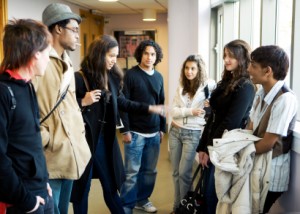 The problem of bullying has received increased public attention in the U.S. and across the world over the past decade. In response to being bullied by their peers, adolescents have often taken drastic measures – including committing suicide.
The problem of bullying has received increased public attention in the U.S. and across the world over the past decade. In response to being bullied by their peers, adolescents have often taken drastic measures – including committing suicide.
The problem is ubiquitous. According to a study conducted by the U.S. Centers for Disease Control, about 20 percent of high school students report being bullied on school property and 15 percent report having been electronically bullied. The rates are even higher for middle school students where 33 percent report being bullied on school property.
Researchers at Harvard University’s Berkman Center for Internet and Society have published a literature review that investigates the intersection between “offline” bullying and “online” or “cyber-bullying“, and make recommendations about the policies and programs that help to prevent bullying.
Here are some of the conclusions detailed in the review:
- Online and offline bullying are often related. A bullying relationship in school often extends to technology devices.
- Offline bullying is more prevalent among middle school students, whereas cyber-bullying is more common among high school students.
- Youth involved in bullying – whether they are the perpetrator or the victim – tend to have more social and academic problems than youth who are not involved, and are also more likely to experience problems later in life.
- Bullying is a form of social interaction that is shaped by social norms of youths and adults as well schools and broader society. Adults – both parents and school leaders – have the ability to impact perceptions of and actions surrounding bullying.
- Bystanders who witness bullying play a role. Their reactions help to determine whether bullying is repeated or not. Bystanders are more likely to ignore cyber-bullying compared with offline bullying.
- The evidence shows that school policies can prevent and intervene in bullying. There are evidence-based “anti-bullying” curricula that are proven to reduce bullying in schools.
- The culture of a school – particularly when students have positive relationships with each other and adults – has an impact on the prevalence of bullying and student’s willingness to report problems.
- Parents can play a role in preventing bullying by modeling positive behaviors and cultivating an open relationship with their children.
Bystanders also experience the impacts of bullying, most often emotional or social problems related to their witnessing bullying, said Jane Powers, Director of the ACT for Youth Center of Excellence at the Bronfenbrenner Center for Translational Research. “Efforts to train bystanders how to appropriately intervene have demonstrated remarkable success,” Powers said “It’s certainly one way to help prevent the problems associated with bullying.”
The take-home message: Bullying is a serious problem in our society today. But the evidence shows there are steps that schools and parents can take to prevent and intervene in bullying.



Bullying needs to be defeated!!
In my school I will talk for my speech about bullying
The teacher said I have 5 to 10 minutes to talk about
I will say why the people bullied others,if the person(victim) didn’t nothing to them why they gonna bullyingm? if you know someone is being bullied just talk to a adult don’t be scared to ask for help they will help you
And here is my message for everybody who is being victim o bullying
i mean why bully if you have to bully cause you have oproblems at home talk it out with someone let it out but dont bully other people just beause you have problems